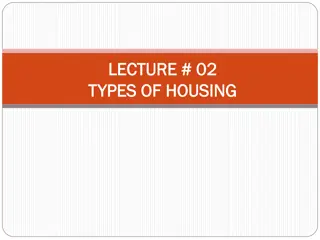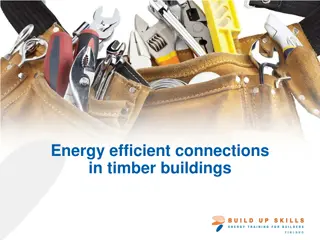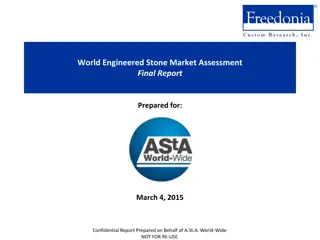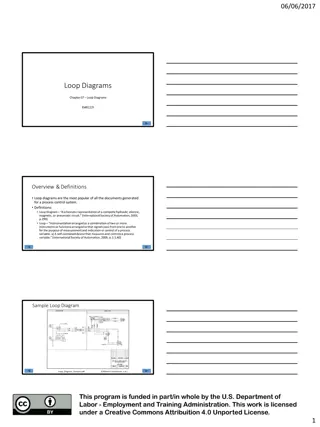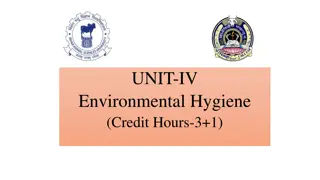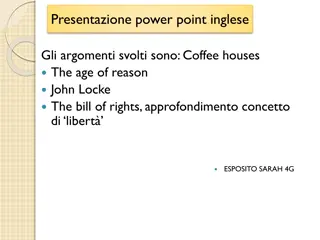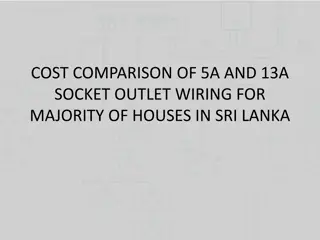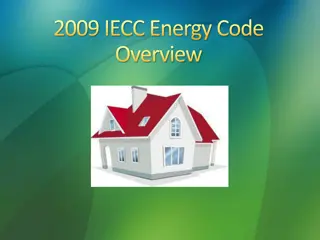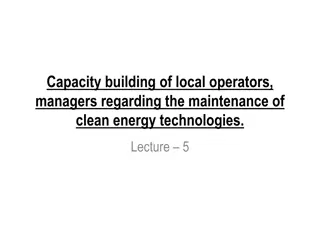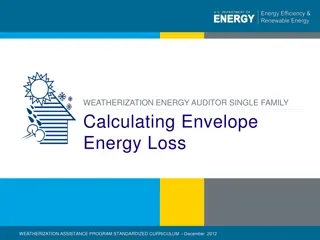Energy-Efficient Building Connections in Stone Houses
Energy-efficient connections in stone houses involve careful sealing and insulation practices to ensure airtightness and durability. From connecting concrete slabs to exterior walls to sealing timber roofs with vapor barrier membranes, these detailed processes aim to enhance energy efficiency and longevity in stone structures.
Download Presentation

Please find below an Image/Link to download the presentation.
The content on the website is provided AS IS for your information and personal use only. It may not be sold, licensed, or shared on other websites without obtaining consent from the author. Download presentation by click this link. If you encounter any issues during the download, it is possible that the publisher has removed the file from their server.
E N D
Presentation Transcript
Energy efficient connections in stone houses
Energy efficient stone structures NB Structures are made airtight. Plastic insulations more common in stone houses. During installation remember: At least 10-20 mm jointing margin along edges of the board. Tongue and groove joints foamed before attaching. Join to clean surfaces; clean insulation with compressed air; remove paste from concrete surfaces. Join at least in two phases allowing airtight film to develop. The joints of vertical and horizontal structures are very important. Heat and moisture deformations and long term resistance must be considered in stone and timber structures. 2 2019
Connection between concrete slab on ground and exterior wall At first exterior wall 1. Footing blocks coated on both surfaces down to the footing. Bitumen-polymer membrane glued to the ashlars and turned on the floor insulation and under the slab. 10 mm-wide cellular polyethylene strip fixed between slab and wall. Joint sealed with elastic sealing compound because of the shrinkage of the slab. 4 2. 3 3. 2 1 4. 3 2019
Ventilated base floor made of stone 1. The bitumen-polymer membrane is installed under the wall as a capillary break and to ensure the end joint is vapour proof. 2. The horizontal joints between concrete structure and foundation block are air proof if concreting is made carefully. 3. Connections between elements are sealed with plaster coat. 4. Air proof foil of timber wall is tightened between the horizontal battening and the base plate of wall. 5. The gap between the bottom of the wall and the floor slab is sealed with polyurethane foam. 4 3 1 5 2 4 2019
Connection between timber roof and stone wall eaves 1. A 1 metre-wide vapour barrier membrane fitted above the block wall. When making the roof, the vapour barrier of the wall is overlapped with the vapour proofing of the roof. The connection is pressed tight with the screw fastening (k300) of the horizontal battening. 2 2. 3 3. 1 5 2019
Sealing the connection between a timber roof and stone exterior walls with a vapour barrier membrane 1. A vapour proof plastic strip is set over an ashlar wall. 2. The strip is stapled to the batten from inside until building the ceiling starts. The batten is also another compression batten in the connection. 3. The vapour-proof foil is overlapped with the vapour proofing of the roof and is pressed between battens using separate screw battens (screw fastening k300) 2 3 1 6 2019
Connection between an insulated block wall and a timber roof levelling under the head plate 1. The air barrier foil of the roof is tightened against the header course by battening (screw fastening k300). 2. The roof truss is levelled under the head plate of the wall and the gap between the head plate and ashlar is foamed. 2 1 7 2019
Connection between an insulated block wall and a timber roof levelling over the head course 1. The air barrier foil of the roof is tightened against the header course by battening (screw fastening k300). 2. When roof truss is levelled over the head plate of the wall, the chamfered header course is installed over the ashlar wall. The gap is foamed. 2 1 8 2019
Vapour proofing of a roof with a cellular plastics insulation panel 1. Roof truss is levelled under the header plate 2. Polyurethane foaming between the board, header plate and ashlar. 1 2 9 2019
Sealing and joints between exterior stone walls and a timber roof - diagonal ceiling 1. A batten, parallel to the roof, is fastened to the end wall by a spacer The vapour-proof foil of the roof is pressed between the batten fastened to the wall and the counterforts of the gable end (screw fastening k300). The gap between the spacers, the counterfort and the ashlar is sealed with polyurethane foam. 1 2. 2 3. 3 10 2019
Connection between concrete sandwich elements and hollow core slabs: non-bearing wall 1. Airtightness of the joint is ensured with welded or glued bitumen-polymer membrane. 1 11 2019
Joints between exterior walls of lightweight concrete house and roof: eaves 1. The connection is sealed with foam. 2. Seal is made sure with elastic caulking. 3. It is recommended to install 200 mm stick-on bitumen-polymer membrane strips over the roof element junctions. 3 1 2 12 2019
Sealing window frames 1. The window is sealed with polyurethane foam 2. A ventilation gap should be left at the outer edge of window 3. The polyurethane foam junction should come up to the gap between the inner leaf of the element and the frame 1 3 2 2 3 13 2019
Consider: What are the critical work phases in an apartment building construction site concerning energy efficiency and quality? Caulking and sealing gaps of the heat insulation in the elements. Making concrete element joints airtight Fastening and jointing heat insulation that is installed on site Covering the floating works of the base floor and the external walls Taking cross-measures of the windows and doors; adjusting the entrance and jointing and caulking the frames Sealing joints of vertical and horizontal structures and considering the transformations 14 2019
Remember Thermal insulation tight against the frame and surfaces Soft thermal insulation with light pressure Hard thermal insulation foamed 1-2 times around. The gap for foam should be 10 25 mm. Vapour-proof foil should not break. It should be stalled in such a way that movement of the frame is allowed. The joints of vapour-proof foil should be pressure fastened if possible. In concrete houses, the lower joint is the most critical joint. In some cases the plaster coat of the floor also seals the joint. The structures should be tight for decades. When choosing materials, consider, for example, vapour-proof tapes. Taping alone is not enough because tapes perish and do not withstand movements due to heat, moisture and snow load. 15 2019



